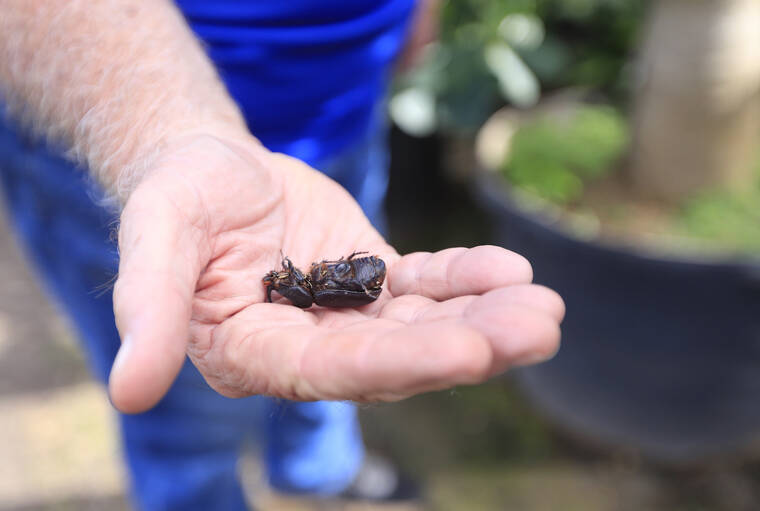Coconut rhinoceros beetles (CRBs) are no mere pest. This invasive species no longer “threatens” to destroy revered heritage palms and valued cash crops: It has destroyed these assets, and the ravages are increasing at an alarming pace.
CRBs kill coconut palms and topple banana trees. They have the potential to wipe out cash crops of coconuts and bananas, and can attack pineapple, damaging the local economy. They attack heritage groves planted by Native Hawaiians long before the plantation era, and threaten Hawaii’s only native palm, the loulu, and the native hala, a species of the Pandanus tree.
CRBs were first spotted in Hawaii, at Joint Base Pearl Harbor-Hickam, in 2013. Some eradication efforts have been made, but they have been limited and insufficient.
In 2023, Hawaii’s Department of Agriculture (HDOA) and CRB Response, administered by the University of Hawaii’s Research Corp., declared the beetles irremediably established on Oahu. Treatment at individual sites stopped, and the team focuses solely on keeping populations down around ports, in an attempt to contain beetles on the island.
This year, commenting on a five-year-long struggle with a beetle infestation at Mililani Agricultural Park that included an ineffective single visit for treatment approved by the HDOA, Hawaii Farm Bureau executive director Brian Miyamoto questioned whether the state’s banana crop could be destroyed.
“Are we no longer going to be able to have bananas?” he asked, in an interview with KHON.
The containment strategy has been spotty, as indicated by repeated findings of CRB larva and beetles on neighbor islands. On Saturday, the Star-Advertiser reported that a beetle was detected in a Hawaii island trap just 200 yards from the last detection, in October, when a Waikoloa resident discovered six larvae in a rotted palm tree stump.
Typically, beetles have been detected after a delivery of mulch, soil or compost, and HDOA “asks” residents to inspect their purchases. This is not enough.
In early 2023, HDOA unveiled new biosecurity rules that would allow for the quarantine of pest-infested plants and materials if detected at a distribution site, such as a nursery. Public hearings with copious testimony in favor of the actions were held early this year. Yet the agency has repeatedly delayed acting to adopt the rules.
This is of a piece with the agency’s excessive deference to commercial operations, such as nurseries, and corresponding, damaging disinterest in taking effective action against destructive invasive species.
This year, legislation was passed establishing HDOA accountability for addressing the problem of invasive pest spread. The Legislature also authorized an unprecedented amount of funding to combat invasive species in House Bill 2619, now Act 231. In July, Gov. Josh Green cut that funding in half — but it still amounted to a historic amount of support, at approximately $10 million.
Money has been allocated to CRB response funds, risk assessment and biosecurity facility planning funds, and salaries allotted for plant inspection, environmental health and support positions. HDOA has created grants for nonprofits working to eradicate the invader, and for management of green waste. The public now needs to see results, in the form of active, effective eradication and containment efforts.
The Legislature also passed a law authorizing HDOA to declare a “biosecurity emergency” giving HDOA and the governor ability to take action to prevent spread of invasive pests. Gov. Green vetoed Senate Bill 572 because it allowed “requisition” of ships and transport, which he called “an extreme power.”
Perhaps so; but the frustrations with inaction over devastating pest invasions remain. The governor himself is ultimately responsible for acting on this pressing emergency.

